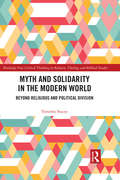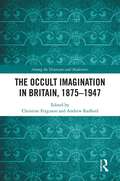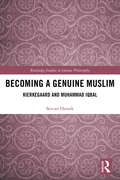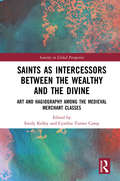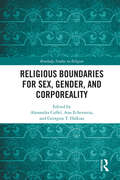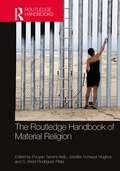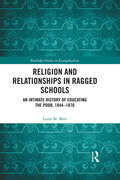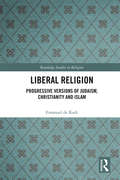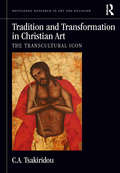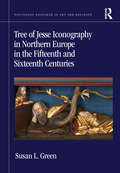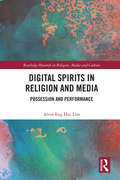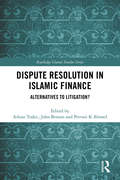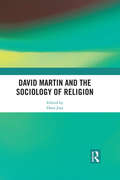- Table View
- List View
Myth and Solidarity in the Modern World: Beyond Religious and Political Division (Routledge New Critical Thinking in Religion, Theology and Biblical Studies)
by Timothy StaceyIn the context of the rise of reactionary politics across the globe, this book seeks new ways of developing solidarity across religious, political and economic differences. Drawing on an increasingly influential Christian theological movement, postliberalism, it claims that the dominance of liberal, secular rationality has blinded people to the fundamental role of transcendence and myth in developing solidarity. The result is either atrophy, or a retrenching in divisive myths of faith, race, nation or economic status. Liberalism is now a dominant force across the globe. But its resonance in the Anglo-Saxon West, from which it originates and has been most fully realized, is relatively underexplored. The book thus follows two simultaneous lines of enquiry. Firstly, a genealogical study of social scientific and policy iterations of the relationship between belief and solidarity in the Anglo-Saxon West, placing postliberal theory into dialogue with the sociology and anthropology of religion, politics and economics. Secondly, it draws from original ethnographic research with groups in London, UK, that seek to develop solidarity in the face of deep-seated difference. By bringing a new way of framing these contentious debates about contemporary society, this research offers tools for more productive conversations around religious and political topics, in particular concluding with a clear policy proposal. It is, therefore, a useful resource for both academics of theology and religious studies, political philosophy, sociology and anthropology; and for politicians, policy makers and practitioners hoping to develop solidarity in the modern world.
The Occult Imagination in Britain, 1875-1947 (Among the Victorians and Modernists)
by Christine Ferguson Andrew RadfordBetween 1875 and 1947, a period bookended, respectively, by the founding of the Theosophical Society and the death of notorious occultist celebrity Aleister Crowley, Britain experienced an unparalleled efflorescence of engagement with unusual occult schema and supernatural phenomena such as astral travel, ritual magic, and reincarnationism. Reflecting the signal array of responses by authors, artists, actors, impresarios and popular entertainers to questions of esoteric spirituality and belief, this interdisciplinary collection demonstrates the enormous interest in the occult during a time typically associated with the rise of secularization and scientific innovation. The contributors describe how the occult realm functions as a turbulent conceptual and affective space, shifting between poles of faith and doubt, the sacrosanct and the profane, the endemic and the exotic, the forensic and the fetishistic. Here, occultism emerges as a practice and epistemology that decisively shapes the literary enterprises of writers such as Dion Fortune and Arthur Machen, artists such as Pamela Colman Smith, and revivalists such as Rolf Gardiner
The Occult Imagination in Britain, 1875-1947 (Among the Victorians and Modernists)
by Christine Ferguson Andrew RadfordBetween 1875 and 1947, a period bookended, respectively, by the founding of the Theosophical Society and the death of notorious occultist celebrity Aleister Crowley, Britain experienced an unparalleled efflorescence of engagement with unusual occult schema and supernatural phenomena such as astral travel, ritual magic, and reincarnationism. Reflecting the signal array of responses by authors, artists, actors, impresarios and popular entertainers to questions of esoteric spirituality and belief, this interdisciplinary collection demonstrates the enormous interest in the occult during a time typically associated with the rise of secularization and scientific innovation. The contributors describe how the occult realm functions as a turbulent conceptual and affective space, shifting between poles of faith and doubt, the sacrosanct and the profane, the endemic and the exotic, the forensic and the fetishistic. Here, occultism emerges as a practice and epistemology that decisively shapes the literary enterprises of writers such as Dion Fortune and Arthur Machen, artists such as Pamela Colman Smith, and revivalists such as Rolf Gardiner
Becoming a Genuine Muslim: Kierkegaard and Muhammad Iqbal (Routledge Studies in Islamic Philosophy)
by Sevcan OzturkDespite the apparent lack of any cultural and religious connection between Kierkegaard and Iqbal, their philosophical and religious concerns and their methods of dealing with these concerns show certain parallels. This book provides a Kierkegaardian reading of Muhammad Iqbal’s idea of becoming a genuine Muslim. It reflects on the parallels between the philosophical approaches of Kierkegaard and Iqbal, and argues that, though there are certain parallels between their approaches, there is a significant difference between their philosophical stances. Kierkegaard was concerned with developing an existential dialectics; Iqbal, however, focused mostly on the identification of the problems of the modern Muslim world. As a result, Iqbal’s idea of becoming a genuine Muslim – the practical aspect of his thought and one of the most central issues of his philosophy – seems to be unclear and even contradictory at points. This book therefore uses the parallels between the two philosophers' endeavours and the notions developed by Kierkegaard to provide a strong hermeneutical tool for clarifying where the significance of Iqbal’s idea of becoming a Muslim lies. By bringing together two philosophers from different cultural, traditional and religious backgrounds, this book will appeal to students and scholars of Comparative Politics, Contemporary Islamic Philosophy and the Philosophy of Religion.
Becoming a Genuine Muslim: Kierkegaard and Muhammad Iqbal (Routledge Studies in Islamic Philosophy)
by Sevcan OzturkDespite the apparent lack of any cultural and religious connection between Kierkegaard and Iqbal, their philosophical and religious concerns and their methods of dealing with these concerns show certain parallels. This book provides a Kierkegaardian reading of Muhammad Iqbal’s idea of becoming a genuine Muslim. It reflects on the parallels between the philosophical approaches of Kierkegaard and Iqbal, and argues that, though there are certain parallels between their approaches, there is a significant difference between their philosophical stances. Kierkegaard was concerned with developing an existential dialectics; Iqbal, however, focused mostly on the identification of the problems of the modern Muslim world. As a result, Iqbal’s idea of becoming a genuine Muslim – the practical aspect of his thought and one of the most central issues of his philosophy – seems to be unclear and even contradictory at points. This book therefore uses the parallels between the two philosophers' endeavours and the notions developed by Kierkegaard to provide a strong hermeneutical tool for clarifying where the significance of Iqbal’s idea of becoming a Muslim lies. By bringing together two philosophers from different cultural, traditional and religious backgrounds, this book will appeal to students and scholars of Comparative Politics, Contemporary Islamic Philosophy and the Philosophy of Religion.
Saints as Intercessors between the Wealthy and the Divine: Art and Hagiography among the Medieval Merchant Classes (Sanctity in Global Perspective)
by Emily Kelley Cynthia Turner CampOffering snapshots of mercantile devotion to saints in different regions, this volume is the first to ask explicitly how merchants invoked saints, and why. Despite medieval and modern stereotypes of merchants as godless and avaricious, medieval traders were highly devout – and rightly so. Overseas trade was dangerous, and merchants’ commercial activities were seen as jeopardizing their souls. Merchants turned to saints for protection and succor, identifying those most likely to preserve their goods, families, reputations, and souls. The essays in this collection, written from diverse angles, range across later medieval western Europe, from Spain to Italy to England and the Hanseatic League. They offer a multi-disciplinary examination of the ways that medieval merchants, from petty traders to influential overseas wholesalers, deployed the cults of saints. Three primary themes are addressed: danger, community, and the unity of spiritual and cultural capital. Each of these themes allows the international panel of contributors to demonstrate the significant role of saints in mercantile life. This book is unique in its exploration of saints and commerce, shedding light on the everyday role religion played in medieval life. As such, it will be of keen interest to scholars of religious history, medieval history, art history, and literature.
Saints as Intercessors between the Wealthy and the Divine: Art and Hagiography among the Medieval Merchant Classes (Sanctity in Global Perspective)
Offering snapshots of mercantile devotion to saints in different regions, this volume is the first to ask explicitly how merchants invoked saints, and why. Despite medieval and modern stereotypes of merchants as godless and avaricious, medieval traders were highly devout – and rightly so. Overseas trade was dangerous, and merchants’ commercial activities were seen as jeopardizing their souls. Merchants turned to saints for protection and succor, identifying those most likely to preserve their goods, families, reputations, and souls. The essays in this collection, written from diverse angles, range across later medieval western Europe, from Spain to Italy to England and the Hanseatic League. They offer a multi-disciplinary examination of the ways that medieval merchants, from petty traders to influential overseas wholesalers, deployed the cults of saints. Three primary themes are addressed: danger, community, and the unity of spiritual and cultural capital. Each of these themes allows the international panel of contributors to demonstrate the significant role of saints in mercantile life. This book is unique in its exploration of saints and commerce, shedding light on the everyday role religion played in medieval life. As such, it will be of keen interest to scholars of religious history, medieval history, art history, and literature.
Religious Boundaries for Sex, Gender, and Corporeality (Routledge Studies in Religion)
by Alexandra Cuffel Ana Echevarría Georgios T. HalkiasThe ambiguity concerning the interpretation of the ‘physical body’ in religious thought is not peculiar to any given religion, but is discernible in the scriptures, practices, and disciplines in most of the world’s major religious traditions. This book seeks to address the nuances of difference within and between religious traditions in the treatment and understanding of what constitutes the body as a carrier of religious meaning and/or vindication of doctrine. Bringing together an international team of contributors from different disciplines, this collection addresses the intersection of religion, gender, corporeality and/or sexuality in various Western and Eastern cultures. The book analyses instances when religious meaning is attributed to the human body’s physicality and its mechanics in contrast to imagined or metaphorical bodies. In other cases, it is shown that the body may function either as a vehicle or a hindrance for mystical knowledge. The chapters are arranged chronologically and across religious orientations, to offer a differentiated view on the body from a global perspective. This collection is an exciting exploration of religion and the human body. As such, it will be of great interest to scholars in religious studies, theology, Islamic studies, South Asian studies, history of religions and gender studies.
Religious Boundaries for Sex, Gender, and Corporeality (Routledge Studies in Religion)
by Alexandra Cuffel Ana Echevarría Georgios T. HalkiasThe ambiguity concerning the interpretation of the ‘physical body’ in religious thought is not peculiar to any given religion, but is discernible in the scriptures, practices, and disciplines in most of the world’s major religious traditions. This book seeks to address the nuances of difference within and between religious traditions in the treatment and understanding of what constitutes the body as a carrier of religious meaning and/or vindication of doctrine. Bringing together an international team of contributors from different disciplines, this collection addresses the intersection of religion, gender, corporeality and/or sexuality in various Western and Eastern cultures. The book analyses instances when religious meaning is attributed to the human body’s physicality and its mechanics in contrast to imagined or metaphorical bodies. In other cases, it is shown that the body may function either as a vehicle or a hindrance for mystical knowledge. The chapters are arranged chronologically and across religious orientations, to offer a differentiated view on the body from a global perspective. This collection is an exciting exploration of religion and the human body. As such, it will be of great interest to scholars in religious studies, theology, Islamic studies, South Asian studies, history of religions and gender studies.
The Routledge Handbook of Material Religion (Routledge Handbooks in Religion)
by Pooyan Tamimi Arab Jennifer Scheper Hughes S. Brent Rodríguez-PlateThe Routledge Handbook of Material Religion places objects and bodies at the center of scholarly studies of religious life and practice. Propelling forward the study of material religion, the Handbook first reveals the deep philosophical roots of its key categories and then advances new critical analytics, such as queer materialities, inescapable material entanglements, and hyperobjects that explode the small-scale personal view on religions. The Handbook comprises thirty chapters, written by an international team of contributors who offer a global perspective of religious pasts and presents, divided into four thematic parts: • Genealogies of Material Religion • Materializing the Terms of the Study of Religion • Entanglements, Entrapment, Escaping • Hyperobjects, or How Ginormous Things Affect Religions In these four parts, the study of material religion is redirected towards systematic, critical interrogations of the imbrication of religious structures of power with racial, economic, political, and gendered forms of domination. From Spinoza’s political theology to African philosophies of ubuntu; from the queer materialities of Mesoamerican religion to the Satanic Temple of the United States; from Islamic love and sacrifice in human-animal entanglements to Shia militants’ attachment to weaponry; from epidemic cataclysm in Latin America to vast infrastructures and the gathering of millions in India’s Kumbh Mela, the study of material religion proves to be the study par excellence of the human condition. The Handbook is essential reading for students and researchers in religious studies, anthropology, history, and media studies, and will also be of interest to those in related fields such as archeology, sociology, and philosophy.
The Routledge Handbook of Material Religion (Routledge Handbooks in Religion)
by Pooyan Tamimi Arab Jennifer Scheper Hughes S. Brent Rodríguez-PlateThe Routledge Handbook of Material Religion places objects and bodies at the center of scholarly studies of religious life and practice. Propelling forward the study of material religion, the Handbook first reveals the deep philosophical roots of its key categories and then advances new critical analytics, such as queer materialities, inescapable material entanglements, and hyperobjects that explode the small-scale personal view on religions. The Handbook comprises thirty chapters, written by an international team of contributors who offer a global perspective of religious pasts and presents, divided into four thematic parts: • Genealogies of Material Religion • Materializing the Terms of the Study of Religion • Entanglements, Entrapment, Escaping • Hyperobjects, or How Ginormous Things Affect Religions In these four parts, the study of material religion is redirected towards systematic, critical interrogations of the imbrication of religious structures of power with racial, economic, political, and gendered forms of domination. From Spinoza’s political theology to African philosophies of ubuntu; from the queer materialities of Mesoamerican religion to the Satanic Temple of the United States; from Islamic love and sacrifice in human-animal entanglements to Shia militants’ attachment to weaponry; from epidemic cataclysm in Latin America to vast infrastructures and the gathering of millions in India’s Kumbh Mela, the study of material religion proves to be the study par excellence of the human condition. The Handbook is essential reading for students and researchers in religious studies, anthropology, history, and media studies, and will also be of interest to those in related fields such as archeology, sociology, and philosophy.
Religion and Relationships in Ragged Schools: An Intimate History of Educating the Poor, 1844-1870 (Routledge Studies in Evangelicalism)
by Laura M. MairFocusing on the interaction between teachers and scholars, this book provides an intimate account of "ragged schools" that challenges existing scholarship on evangelical child-saving movements and Victorian philanthropy. With Lord Shaftesbury as their figurehead, these institutions provided a free education to impoverished children. The primary purpose of the schools, however, was the salvation of children’s souls. Using promotional literature and local school documents, this book contrasts the public portrayal of children and teachers with that found in practice. It draws upon evidence from schools in Scotland and England, giving insight into the achievements and challenges of individual institutions. An intimate account is constructed using the journals maintained by Martin Ware, the superintendent of a North London school, alongside a cache of letters that children sent him. This combination of personal and national perspectives adds nuance to the narratives often imposed upon historic philanthropic movements. Investigating how children responded to the evangelistic messages and educational opportunities ragged schools offered, this book will be of keen interest to historians of education, emigration, religion, as well as of the nineteenth century more broadly.
Religion and Relationships in Ragged Schools: An Intimate History of Educating the Poor, 1844-1870 (Routledge Studies in Evangelicalism)
by Laura M. MairFocusing on the interaction between teachers and scholars, this book provides an intimate account of "ragged schools" that challenges existing scholarship on evangelical child-saving movements and Victorian philanthropy. With Lord Shaftesbury as their figurehead, these institutions provided a free education to impoverished children. The primary purpose of the schools, however, was the salvation of children’s souls. Using promotional literature and local school documents, this book contrasts the public portrayal of children and teachers with that found in practice. It draws upon evidence from schools in Scotland and England, giving insight into the achievements and challenges of individual institutions. An intimate account is constructed using the journals maintained by Martin Ware, the superintendent of a North London school, alongside a cache of letters that children sent him. This combination of personal and national perspectives adds nuance to the narratives often imposed upon historic philanthropic movements. Investigating how children responded to the evangelistic messages and educational opportunities ragged schools offered, this book will be of keen interest to historians of education, emigration, religion, as well as of the nineteenth century more broadly.
Liberal Religion: Progressive versions of Judaism, Christianity and Islam (Routledge Studies in Religion)
by Emanuel de KadtIn recent years, there has been an upsurge of interest in religion and religious issues. Some have linked this to a neo-liberal form of individualism, while others noted that secularism has left people bereft of a humanly necessary link with the transcendent. The importance of identity issues has also been remarked upon. This book examines how liberal forms of religion are allowing people to engage with religion on their own terms, while also feeling part of something more universal. Looking at liberal approaches to the Abrahamic faiths – Judaism, Protestant and Roman Catholic Christianity and Islam – this book teases out how postmodern culture has shaped the way in which people engage with these religions. It also compares and contrasts how liberal thinking and theology have been expressed in each of the faiths examined, as well as the reactionary responses to its emergence. By considering how liberalism has influenced the narrative around the Abrahamic faiths, this book demonstrates how malleable faith and spirituality can be. As such, it will be of interest to scholars working in Religious Studies, Theology, Sociology and Cultural Anthropology.
Liberal Religion: Progressive versions of Judaism, Christianity and Islam (Routledge Studies in Religion)
by Emanuel de KadtIn recent years, there has been an upsurge of interest in religion and religious issues. Some have linked this to a neo-liberal form of individualism, while others noted that secularism has left people bereft of a humanly necessary link with the transcendent. The importance of identity issues has also been remarked upon. This book examines how liberal forms of religion are allowing people to engage with religion on their own terms, while also feeling part of something more universal. Looking at liberal approaches to the Abrahamic faiths – Judaism, Protestant and Roman Catholic Christianity and Islam – this book teases out how postmodern culture has shaped the way in which people engage with these religions. It also compares and contrasts how liberal thinking and theology have been expressed in each of the faiths examined, as well as the reactionary responses to its emergence. By considering how liberalism has influenced the narrative around the Abrahamic faiths, this book demonstrates how malleable faith and spirituality can be. As such, it will be of interest to scholars working in Religious Studies, Theology, Sociology and Cultural Anthropology.
Tradition and Transformation in Christian Art: The Transcultural Icon (Routledge Research in Art and Religion)
by C.A. TsakiridouTradition and Transformation in Christian Art approaches tradition and transculturality in religious art from an Orthodox perspective that defines tradition as a dynamic field of exchanges and synergies between iconographic types and their variants. Relying on a new ontology of iconographic types, it explores one of the most significant ascetical and eschatological Christian images, the King of Glory (Man of Sorrows). This icon of the dead-living Christ originated in Byzantium, migrated west, and was promoted in the New World by Franciscan and Dominican missions. Themes include tensions between Byzantine and Latin spiritualities of penance and salvation, the participation of the body and gender in deification, and the theological plasticity of the Christian imaginary. Primitivist tendencies in Christian eschatology and modernism place avant-garde interest in New Mexican santos and Greek icons in tradition.
Tradition and Transformation in Christian Art: The Transcultural Icon (Routledge Research in Art and Religion)
by C.A. TsakiridouTradition and Transformation in Christian Art approaches tradition and transculturality in religious art from an Orthodox perspective that defines tradition as a dynamic field of exchanges and synergies between iconographic types and their variants. Relying on a new ontology of iconographic types, it explores one of the most significant ascetical and eschatological Christian images, the King of Glory (Man of Sorrows). This icon of the dead-living Christ originated in Byzantium, migrated west, and was promoted in the New World by Franciscan and Dominican missions. Themes include tensions between Byzantine and Latin spiritualities of penance and salvation, the participation of the body and gender in deification, and the theological plasticity of the Christian imaginary. Primitivist tendencies in Christian eschatology and modernism place avant-garde interest in New Mexican santos and Greek icons in tradition.
Tree of Jesse Iconography in Northern Europe in the Fifteenth and Sixteenth Centuries (Routledge Research in Art and Religion)
by Susan L. GreenThis book is the first detailed investigation to focus on the late medieval use of Tree of Jesse imagery, traditionally a representation of the genealogical tree of Christ. In northern Europe, from the mid-fifteenth to the early sixteenth centuries, it could be found across a wide range of media. Yet, as this book vividly illustrates, it had evolved beyond a simple genealogy into something more complex, which could be modified to satisfy specific religious requirements. It was also able to function on a more temporal level, reflecting not only a clerical preoccupation with a sense of communal identity, but a more general interest in displaying a family’s heritage, continuity and/or social status. It is this dynamic and polyvalent element that makes the subject so fascinating.
Tree of Jesse Iconography in Northern Europe in the Fifteenth and Sixteenth Centuries (Routledge Research in Art and Religion)
by Susan L. GreenThis book is the first detailed investigation to focus on the late medieval use of Tree of Jesse imagery, traditionally a representation of the genealogical tree of Christ. In northern Europe, from the mid-fifteenth to the early sixteenth centuries, it could be found across a wide range of media. Yet, as this book vividly illustrates, it had evolved beyond a simple genealogy into something more complex, which could be modified to satisfy specific religious requirements. It was also able to function on a more temporal level, reflecting not only a clerical preoccupation with a sense of communal identity, but a more general interest in displaying a family’s heritage, continuity and/or social status. It is this dynamic and polyvalent element that makes the subject so fascinating.
Digital Spirits in Religion and Media: Possession and Performance (Routledge Research in Religion, Media and Culture)
by Alvin Eng LimIn many contemporary and popular forms of religious practice, digital technology and the spiritual are inseparable. Ranging from streaming broadcasts of spiritual possessions to screenings of mass prayer conferences in stadiums, spirits and divinities now have new forms in which they can materialise. By offering the notion of ‘digital spirits’, this book critically attends to the intersections of digital media and spiritual beings. It also puts forward a new performative perspective on how they interact. Taking cues from the work of Stewart Hoover and Heidi Campbell, among others, the book begins with an outline of the current debates around religion, performance and digital media. It then moves on to examine how mediality and religion, where embodied practices are carried out alongside virtual practices, work together in contemporary Asia. These case studies focus on lived religious practices in combination with various forms of media, and so help demonstrate that digital technology in particular reveals the layered processes of spirituality in practice. Gods and divinities have always relied on media to manifest, and this book is a fascinating exploration of how digital media has continued that tradition and taken it in new directions. As such, it will be of great interest to scholars of religious studies, digital media and performance studies.
Digital Spirits in Religion and Media: Possession and Performance (Routledge Research in Religion, Media and Culture)
by Alvin Eng LimIn many contemporary and popular forms of religious practice, digital technology and the spiritual are inseparable. Ranging from streaming broadcasts of spiritual possessions to screenings of mass prayer conferences in stadiums, spirits and divinities now have new forms in which they can materialise. By offering the notion of ‘digital spirits’, this book critically attends to the intersections of digital media and spiritual beings. It also puts forward a new performative perspective on how they interact. Taking cues from the work of Stewart Hoover and Heidi Campbell, among others, the book begins with an outline of the current debates around religion, performance and digital media. It then moves on to examine how mediality and religion, where embodied practices are carried out alongside virtual practices, work together in contemporary Asia. These case studies focus on lived religious practices in combination with various forms of media, and so help demonstrate that digital technology in particular reveals the layered processes of spirituality in practice. Gods and divinities have always relied on media to manifest, and this book is a fascinating exploration of how digital media has continued that tradition and taken it in new directions. As such, it will be of great interest to scholars of religious studies, digital media and performance studies.
Dispute Resolution in Islamic Finance: Alternatives to Litigation? (Routledge Islamic Studies Series)
by Adnan Trakic John Benson Pervaiz K AhmedDispute Resolution in Islamic Finance addresses how best to handle disputes within Islamic finance. It examines how they can be resolved in a less confrontational manner and ensure such disagreements are settled in a just and fair way. There has been little focus on how disputes within Islamic finance are resolved. As a result, many of these disputes are resolved through litigation, notwithstanding that the various jurisdictions and court systems are generally poorly equipped to handle such matters. This book addresses this gap in our knowledge by focusing on five centres of Islamic finance: the United Kingdom, the United States of America, Malaysia, the Kingdom of Saudi Arabia and the United Arab Emirates. Before exploring these countries in detail, the book considers the issues of the choice of law within Islamic finance as well the prevailing forms of dispute resolution in this form of finance. The book brings together a group of leading scholars who are all specialists on the subject in the countries they examine. It is a key resource for students and researchers of Islamic finance, and aimed at lawyers, finance professionals, industry practitioners, consultancy firms, and academics.
Dispute Resolution in Islamic Finance: Alternatives to Litigation? (Routledge Islamic Studies Series)
Dispute Resolution in Islamic Finance addresses how best to handle disputes within Islamic finance. It examines how they can be resolved in a less confrontational manner and ensure such disagreements are settled in a just and fair way. There has been little focus on how disputes within Islamic finance are resolved. As a result, many of these disputes are resolved through litigation, notwithstanding that the various jurisdictions and court systems are generally poorly equipped to handle such matters. This book addresses this gap in our knowledge by focusing on five centres of Islamic finance: the United Kingdom, the United States of America, Malaysia, the Kingdom of Saudi Arabia and the United Arab Emirates. Before exploring these countries in detail, the book considers the issues of the choice of law within Islamic finance as well the prevailing forms of dispute resolution in this form of finance. The book brings together a group of leading scholars who are all specialists on the subject in the countries they examine. It is a key resource for students and researchers of Islamic finance, and aimed at lawyers, finance professionals, industry practitioners, consultancy firms, and academics.
David Martin and the Sociology of Religion
by Hans JoasDavid Martin is a pioneer of a political sociology of religion that integrates a combined analysis of nationalism and political religions with the history of religion. He was one of the first critics of the so-called secularization thesis, and his historical orientation makes him one of the few outstanding scholars who have continued the work begun by Max Weber and Emile Durkheim. This collection provides the first scholarly overview of his hugely influential work and includes a chapter written by David Martin himself. Starting with an introduction that contextualises David Martin’s theories on the sociology of religion, both currently and historically, this volume aims to cover David Martin’s lifework in its entirety. An international panel of contributors sheds new light on his studies of particular geographical areas (Britain, Latin America, Scandinavia) and on certain systematic fields (secularization, violence, music, Pentecostalism, the relation between sociology and theology). David Martin’s concluding chapter addresses the critical points raised in response to his theories. This book addresses one of the key figures in the development of the sociology of religion, and as such it will be of great interest to all scholars of the sociology of religion.
David Martin and the Sociology of Religion
by Hans JoasDavid Martin is a pioneer of a political sociology of religion that integrates a combined analysis of nationalism and political religions with the history of religion. He was one of the first critics of the so-called secularization thesis, and his historical orientation makes him one of the few outstanding scholars who have continued the work begun by Max Weber and Emile Durkheim. This collection provides the first scholarly overview of his hugely influential work and includes a chapter written by David Martin himself. Starting with an introduction that contextualises David Martin’s theories on the sociology of religion, both currently and historically, this volume aims to cover David Martin’s lifework in its entirety. An international panel of contributors sheds new light on his studies of particular geographical areas (Britain, Latin America, Scandinavia) and on certain systematic fields (secularization, violence, music, Pentecostalism, the relation between sociology and theology). David Martin’s concluding chapter addresses the critical points raised in response to his theories. This book addresses one of the key figures in the development of the sociology of religion, and as such it will be of great interest to all scholars of the sociology of religion.
